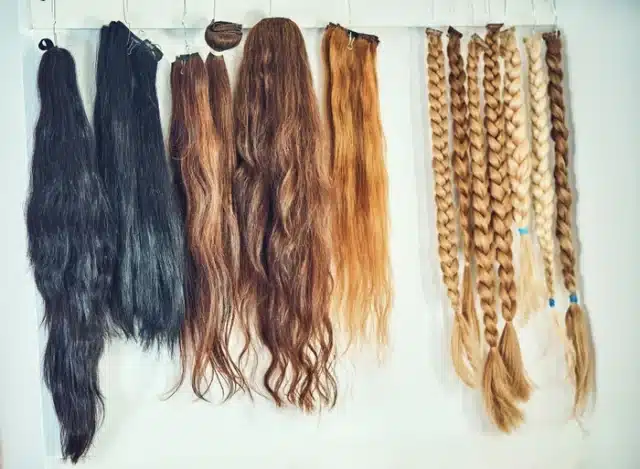A hair extension is a popular accessory for people who want their preliminary hair to extend, add quantity, and enhance fullness to their hairstyles. Hair extensions have been popular for years now, but they are sometimes the same way they are today.
A discreet and effective one that is gaining a lot of attention provides comfort and flexibility, has seamless hair integration methods, and has a natural appearance. Hair extensions are well known today, but most people may need to learn how different types of extensions and application techniques can completely change the hair game.
Why Choose Hair Extensions?
Hair extensions are not just for drastic styling; subtle yet critical enhancements are always welcome. Extensions can create all sorts of looks, from achieving extra body and volume to filling in thinning areas or adding length for a particular occasion style.
Hair extensions can do a lot for some in terms of confidence! Fine or thinning hair can be chosen for the best supplemental, fuller appearance without chemical damage or salon visits. Additionally, they will be a low-maintenance option for those who want a new look but avoid permanent haircuts or colourings.
Hair Extension Methods: A Comparison
There are numerous hair extension methods, each with unique advantages. However, the best method for an individual can vary by hair type, lifestyle, and desired look. Discover some of the most common hair extension methods to ensure a seamless, natural look.
Clip-In Extensions
Clip-in hair extensions are one of the quickest and simplest options and are famous among non-professionals. They can be clipped into pieces of your natural hair and, being so versatile, can quickly come on and off as needed. Clip-in is perfect for those who want to stay out all day and later hide the stuff in some corner of their closet.
Fusion Extensions
Fusion hair extensions are when individual strands of extension hair are bonded to natural hair using a keratin-based bond. Its reputation is long-lasting and realistic, so it is an excellent option if you want to wear extensions for a more extended period. They fuse to your hair, so they match perfectly and give the illusion that you have a very natural, full head of hair.
Micro-Link Extensions
Micro-link (aka microbead) extensions are a semi-permanent option that utilises tiny beads to attach sections of natural hair to extension strands, using a small metal bead to secure the two together. This technique is least damaging to the hair without any heat or glue. Unlike other extensions, they are adjustable and relatively long-lasting for two to three months with proper treatment.
Tape-In Extensions
Although there are different kinds of extensions, specific techniques have gained the most popularity due to how easily they can be applied and the minimal maintenance involved. For example, tape in hair extensions is a popular way to achieve an invisible and natural finish. In the tape-in method, wefts of hair are placed in small sections of your natural hair and bonded with double-sided adhesive tape. One of the most talked-about reasons this method is so comfortable is because the tapes are thin and lightweight.
Tape-in extensions provide a versatile option for those who want hair that matches their texture but are still deciding whether to commit. Unlike sew-ins, which can be thick and bulky, tape-in extensions lie flat against the scalp. The process features a firm yet gentle adhesive technique that keeps the extensions in place and helps remove them easily without damaging the natural hair.
Maintaining the Health of Your Natural Hair
No matter which sort of extensions you decide on, proper care and maintenance are needed to ensure your hair and extensions remain in excellent condition. To prolong the life of your extensions, it is essential to wash and condition them regularly and stay away from harsh products that may harm the hair or adhesive. Moreover, when getting tape in hair extensions or other hair extensions, you must put them in a trained pro. This causes the extensions to be seated so your natural hair has no added stress.
Another factor when getting hair extensions is their removal. While other methods, like tape-in extensions, require a professional to remove them correctly without damaging the natural hair, pull-off methods such as clip-ins and micro-links are accessible at home. If you want to protect the health of your natural hair, follow aftercare instructions and consult a professional.
Choosing the Right Extension Method for You
There are so many methods out there that choosing the proper hair extension method can seem daunting. You can choose the best, but remember to focus on your hair type, lifestyle, and goals first. Clip-in extensions are the easiest option for a temporary change, for example, if you want to create beautiful long hair for a special occasion. Tape-in or micro-link extensions may provide a more enduring fix for longer-lasting fullness or length.
Visiting a hair stylist or extension specialist can help you decide which option is best for you. Salons offer consultations, during which you can discuss your hair goals and what styles they suggest for achieving that perfect look.
Conclusion
Hair extensions are a flexible solution for those looking to boost their natural hair with length, volume, and fullness. There are many ways to work with extensions, from clip-ins to tape-ins, so there is a method for every hair type and life. Whichever way you go, keep it maintained, and ask for help from a qualified expert if necessary so that everything remains as seamless and realistic-looking as possible. Hair extensions also help people improve their looks.

A professional writer with over a decade of incessant writing skills. Her topics of interest and expertise range from health, nutrition and psychology.




